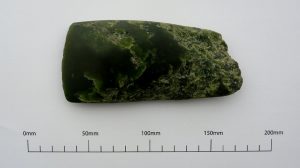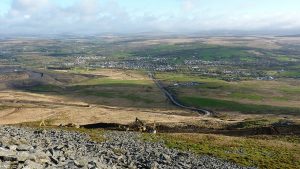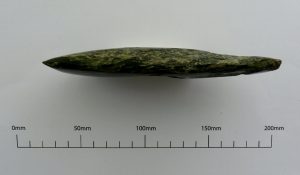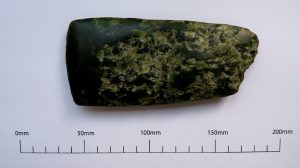YThe Cynon Valley Museum’s collection stretches back to the Neolithic (4100BC – 2500BC) when people had recently introduced farming in Wales, but had not discovered the technology to manufacture metal tools. During this time, people lived in small permanent and semi-permanent groups and relied on tools made from stone, bone and wood. In the Cynon Valley, we see evidence of these people. Past archaeological investigations have found flint scrapers and arrow heads in Cwmbach and Aberaman. From hunting deer to cutting meat and preparing pelts, these tools were part of everyday life. But there was one tool above all, more sought after than any other, the axe. Throughout early human history, axes had been part of everyday life. In the Neolithic their importance grew; used to clear woodland, cut wood for fires, and butchering the axe was an essential tool.

ACVMS: 2019.114
A handaxe from Hirwaun
In 2014 a Neolithic stone axehead was discovered ahead of the construction of Mynydd Bwlfa Wind Farm, at Hirwaun. This polished green stone axe was found in spoil from past mining activity. Sadly, as a result of this, we know little about how, where or why it was originally deposited. We know it is likely to have been manufactured between 6000 and 5,100 years ago, at the start of the Neolithic period in Wales. The axe is formed of green serpentine, a stone with no known local sources. Its appearance and internal weakness suggest it crashed against other stones and was probably originally found on a shore edge.
These weaknesses help explain how the axe was manufactured. Most axes would have been knapped into shape (the process of hitting the stone to create a desired shape and blade). The weaknesses of this stone would have made this impossible. It was likely ground down into the desired axe shape, creating the unique appearance seen today, with the scars from underwater collisions still apparent.

View from the dig site.
The Significance of the Axe
From the beginning of the Neolithic the axe was more than just a simple tool; the attempts to understand its importance has seen decades of work by archaeologists internationally. In Britain some of the earliest Neolithic axes found originated in the Alps. These alpine axes, like this axe, are distinctly green, but differ by being made from a different stone, jadeitite. It is thought they were manufactured in the middle of the 5th millennium BC, hundreds of years before arriving in the UK.
Over the intervening years these axes would have been passed down, generation to generation, building up their ancestral connections and a body of myths and stories to accompany them. Just like a family heirloom today, bringing us closer to long lost family members. By the time they reached Britain they would have already been around 500 years old, instilled with the legacy of past owners. These stone axes were more than just tools. They came to represent a different way of life to the hunter gather lifestyle that had already been swept away from much of Europe.

ACVMS: 2019.114
As this new way of life spread across Britain, the supply of Alpine axe head disappeared. The desire for green axes, however, did not. New local sources were found amongst the igneous rocks of Britain and Ireland’s most remote locations. Sources in Ireland, Wales, Cornwall and the Lake District were found and quarried. The source of our axehead remains unknown. Serpentine is relatively scarce in the UK, with no known local sources in South Wales. The closest source is the Lizard peninsular, Cornwall. Further scientific analysis may help identify if this stone is Cornish, but at this time we cannot say. The nature of our stone, likely found close to the shoreline, gives us a further multitude of plausible origin stories from being found in a Cornish river to being washed ashore somewhere along Britain’s coastline. We are unlikely to ever know how this axe reached the Cynon Valley.
From its likely chance discovery, someone saw its potential. They invested time and energy into its creation. They would have been aware of its weaknesses, choosing to wear it down into shape rather than knap it. These weaknesses would have made the axe less effective as a tool, but still they chose to work it to the form we see today. This axe appears to be more than just a tool. Over time it may have become a significant possession, linking its owner to the past and the stories which were passed down generation to generation.
This axe, discovered in the Cynon Valley is part of a much wider narrative: the story of the first farmers in Wales. We will probably never know where it was originally deposited or why; it may have been simply lost or there may be a more complex story behind it. For example, we know from other UK sites that stone axes were placed as “offerings” and involved in religious activity.

ACVMS: 2019.114
Today all we have left of the Neolithic in the Cynon Valley are the remnants of stone tools which were essential to everyday life. Some, such as the axe, would grow in meaning and become much more than just a tool. Thus just as this axe today links us to the ancestors of the Cynon valley, it linked Neolithic people to those who had gone before them.
William Tregaskes, Cynon Valley Museum Trust
Further Reading
Miles D, 2016, The Tale of the Axe: How the Neolithic Revolution Transformed Britain, Thames and Hudson, London and New York
Pannett P, 2014, Lithic Artefact, in, Poucher P, 2014, Mynydd Bwllfa Wind Farm, Hirwaun, Rhondda Cynon Taf: Watching Brief, Archaeology Wales, Llanidloes
Whittle A, 2009, The Neolithic, c. 4000-2400 cal BC: A Changing World, in, Hunter J and Ralston I, 2009 (2nd ed), The Archaeology of Britain: An Introduction from the Earliest Times to the Twenty-First Century, Routledge, London and New York
Thanks for reading!
We’re working hard to bring online content to you during this period of uncertainty. You can see some of these on our Exhibition at Home page. If you’d like to support the Cynon Valley Museum, please share this post with your friends and family. You may also like to make a donation! We’re a registered charity and really appreciate your support.
Like this?
Are you interested in receiving Y Chwa/The Blast, a quarterly newsletter for the Friends of Cynon Valley Museum? Each issue includes collection highlights, museum news, and similar articles to this. Click here to find out more about the Friends Group.
-
[…] You can read more about the history of this item on this blog post. […]
Leave a Comment





Tony Lawrence beat me to it! They were able to trace those axes geochemically back to the exact mine & boulder in the Dolomites. As mentioned there are Serpentinites in Cornwall & also on Holy Island, Anglesey. According to legend Napoleon Bonaparte had a tabletop made of the this Serpentinite.
My name is Leighton hill I am actually the ground worker that found the axe head and handed it to management of Walters group and never heard nothing more about it until looking on Google today 6/12/2020 and would like to see it again I presumed it was thrown away not for the job to be stoped so I’m happy it’s gone to a good home if anyone from the museum could contact me if be very great full.the Archilochus told me at the time it could have come from as far away as southern Spain ?